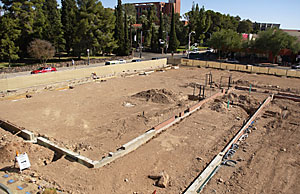 |
|
Chris Coduto/Arizona Daily Wildcat
|
The Marshall Foundation's lot on the corner of University Boulevard and Park Avenue remains vacant. Construction will resume after a delivery of cement arrives next week.
|
|
|
By J. Ferguson
Arizona Daily Wildcat
Tuesday, October 11, 2005
Print this
An empty, fenced-off lot on the corner of East University Boulevard and North Park Avenue will begin to take a new shape next week as a long-awaited delivery of cement finally arrives.
With the delivery of cement and steel, construction work can finally begin for the planned one-story retail building owned by the Marshall Foundation, said Jane McCollum, general manager for the Marshall Foundation.
McCollum said the contractor the Marshall Foundation uses was unable to bring in cement because of a national shortage in such raw materials.
"The concrete was the delay," McCollum explained. "This will be rectified next week."
While cement shortages have delayed the Marshall Foundation construction, projects at the UA have been spared significant delays, although there have been some financial setbacks, said Peter Dourlein, associate director for facilities design and construction.
While the timing of projects has not been significantly affected by the shortage, Dourlein said, the price of construction projects has risen because as cement becomes scarce, its price steadily increases.
Two recent projects, the expansion of the Chemistry building and the new Poetry Center, had to increase their respective budgets to compensate for an estimated 15 percent price increase in raw materials, Dourlein said.
The project to expand the Chemistry building required the UA to ask the Arizona Board of Regents to approve another $1 million to complete the building, Dourlein said.
The budget for the expansion, slated for completion in 2006, is now $46 million after the increase, he said.
The new Poetry Center will also cost an additional $1 million to complete, Dourlein said, which brings the total cost to $6.8 million.
The price increase stems from the national appetite for cement that seems to be insatiable and is outpacing the domestic production, said Ed Sullivan, the chief economist for the Portland Cement Association, an organization that represents cement companies in the United States and Canada.
"We will consume 120 million tons of cement this year and we can only produce 95 million tons," Sullivan said.
Sullivan said the 95 million tons represents the full production capacity of the domestic cement industry working 24 hours a day, seven days a week.
China, in particular, has led to domestic shortages in cement, Sullivan said.
A massive push for imports has increased the cost of shipping freight, and this jump in freight costs makes the cost of shipping cement too expensive for importers to make a profit, Sullivan said.
The reliance on importing cement has placed tremendous demands on availability of cement and the price available in the domestic market. But the rise in prices has not heavily impacted when projects are completed, Dourlein said.
"There were some slowdowns, there were (cement) pours that didn't happen when they should have," Dourlein said. "On a bigger project, that kind of delay got absorbed, so it didn't have a real big impact on the overall project."
Dourlein said he predicts that future large construction projects, like the expansion of the College of Architecture and the planned John and Doris Norton School of Family and Consumer Sciences building, will be finished on time and will be unaffected from the shortage.
Large-scale projects at the UA include the Meinel Optical Sciences building at North Cherry Avenue, the Thomas W. Keating BioResearch building, and the College of Public Health and the College of Nursing Drachman Hall at East Helen Street.
Cost overruns on these projects associated with lack of raw materials have been avoided thus far because many projects were negotiated with contractors and as their prices increased, the contractors were forced to absorb the costs, Dourlein said.
